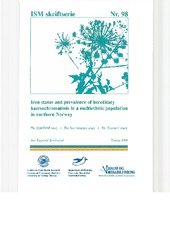| dc.description.abstract | Iron status is influenced by several factors such as nutritional factors and blood loss.
Tron deficiency is one of the most severe and important nutritional deficiencies in the world
today, both in industrialised as well as developing countries [1-3]. In normal subjects the total
daily loss of iron is balanced by an equivalent amount of iron absorbed from the diet. When
this equilibrium is disturbed, due to lack of or too much iron, iron deficiency or overload are
established. Iron deficiencies are caused by several factors as menstrual losses in fertile
women, occult bleeding or a diet low in iron [4]. Iron deficiency affects several body
functions even when anaemia has not developed [5]. Immune status and morbidity of all age
groups are adversely affected by iron deficiency. On the other hand, iron overload can cause
organ damage in severe cases [6]. Inheritance e.g. hereditary haemochromatosis thallasemia
major and blood transfusion can cause severe iron accumulation.<br>
Homozygosis for the C282Y mutation of the candidate gene for haemochromatosis (the HFE
gene) is a common genetic mutation, occurring in 0.3 to 0.7 % of white persons of northern
European descent [7-10]. In 1995 a comprehensive health survey programme (HUNT) was
conducted in Nord-Trøndelag, a county in the middle of Norway, incorporated a large
screening for HH [li]. In total 65 717 (69.8%) people participated. The prevalence of
hereditary haemochromatosis was 0.34% in women and 0.68% in men. Previous screening of
haemochromatosis indicate that the grade of HH is increasing northward, and that hereditary
haemochromatosis is most pronounced among people of north European affiliation [12]. It is
even suggested that is a Viking disease [13].<br>
In Norway iron has been added to food products since 1972. In 2002 this supplementation
was removed because of concerns about iron overload in that part of the population with
hereditary haemochromatosis. Recent data describing the iron status in a Norwegian
population has not been collected. In northern Norway iron measurement in a large population
sample has not been performed.
The population in northern Norway consists mainly of a mixture of people of Sâmi, Kven and
Norwegian origin. There has been substantial interaction between the Såmi and non-Såmi
population for several decades. Nutrition, socioeconomic development and general health
status have a major influence on iron status [14-16]. These issues can lead to differences in
iron levels among groups [17].<br>
The main aims of this research were to evaluate the iron status in ethnically and geographic
diverse populations in northern Norway and in addition investigate the prevalence of
hereditary haemochromatosis and iron overload in the same populations. | en_US |


 English
English norsk
norsk